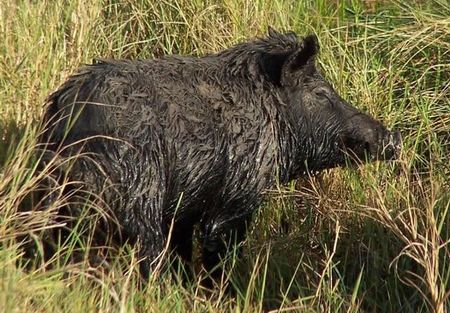Feral hogs are primarily nocturnal, especially during the warmer months, so many times hunters and landowners only see the signs that hogs leave behind. When hog hunting or looking for signs that hogs may be in your area, check for wallowing, rooting, rubs, crossings, trails and scat (feces). Hog wallows are found in muddy areas around creeks, ponds, and springs and are made where hogs root and roll in the mud. Feral hogs will do this to cool off. In addition, the mud protects their skin from the sun, insects, and other hog parasites. Hogs will then rub after wallowing.
Hog rubs are made when feral hogs scratch or rub themselves on tree trunks, telephone poles, fence posts, and rocks leaving a noticeable sign with mud and hair often left clinging. Creosote post, including telephone posts, are highly targeted rubbing areas by hogs. The height of the rub often indicates the size of the hog. If you see mud high up on a tree, post, or pole, then you got a big ole hog out there!
Hog rooting is easily recognized because it looks as if the soil has been plowed or disked. Most often feral hog rooting takes place over a large area. Some rooting “holes” can be as much as three feet deep, which can damage a vehicle if you run off in it.

Feral hogs typically have home ranges that vary from 250 to 10,000 acres in size depending upon habitat availability and condition. The availability of water and food are probably the two most important factors that determine the home range of an individual feral hog. In general, males have larger home ranges than females, particularly during the breeding season. Males, commonly called “boar,” are usually remain solitary until they encounter a receptive sow.
Feral hogs are prolific breeders, making it difficult to control hog populations. Sows can have 2 to 3 litters per year with 4 to 10 young per litter. Good habitat and ideal weather conditions will allow most young to be born in late winter to early spring. The gestation period of a feral hog is about 115 days and litters consists of a 1:1 male to female sex ratio.
A hog track is similar to a deer track, except that the hooves are more rounded and wider in comparison to length. Hog tracks are “square-ish”, in my opinion, while deer tracks are more oblong in general shape. Hog hair is easily distinguished from other mammals and may be found at fence crossings and rubs. If you have barbed-wire around deer feeders or food plots, make sure to check the bottom strand for the presence of coarse hog hair. More often than not, feral hogs are black in coloration, so thick, black hair will let you know that wild or feral hogs are using the area.
Hog scat can also be used to confirm the presence of wild pigs. Hog scat appears very much like that of a small calf, being dropped in several small piles, which is very distinct from deer pellets or predator cord-like droppings.
All wild animals have the potential of being dangerous, especially when wounded or cornered, and feral hogs are no different. In a natural state, feral hogs prefer to run and escape danger and are not considered dangerous. However, extreme caution should be maintained when tracking wounded animals, handling trapped hogs, or if while hog hunting you encounter females (sows) with young. The feral hog’s razor-sharp tusks combined with their lightning speed can cause serious injury, either purposefully or accidentally.
How big would a feral hog have to be in order leave a mud run on a tree 5 feet high?
Jason, a hog of any height could leave mud on a tree that is 5 feet high. Now, if you are talking about a hog that is tall enough to rub on a tree and leave mud 5 foot off the ground, well let’s just say you are going to need more than a friend to help you drag him out!